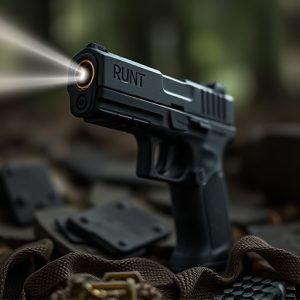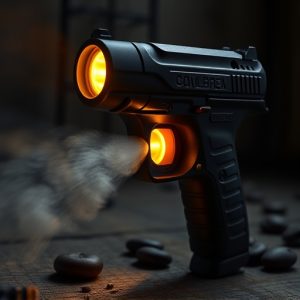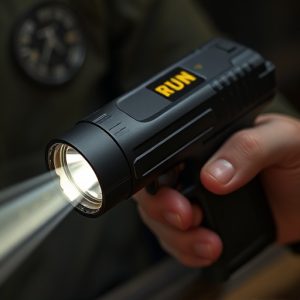Mastering Runt Stun Gun Training for Effective Self-Defense
The Runt Stun Gun is a compact and concealable self-defense device capable of delivering high-volta…….
The Runt Stun Gun is a compact and concealable self-defense device capable of delivering high-voltage shocks to neutralize threats. Effective use of this tool necessitates proper training, which includes understanding its operation, adapting to various environments, and integrating it with broader self-defense strategies. Regular practice helps build the muscle memory and quick reflexes needed for real-world confrontations. Safety is paramount; training should be conducted under the supervision of qualified instructors with appropriate protective gear in controlled settings to prevent harm to trainees or bystanders. Legal compliance is crucial, requiring knowledge of local laws, securing necessary permits, and obtaining the stun gun from legal sources. The Runt Stun Gun's smaller size means users must be precise with their aim, and proficiency involves understanding its operational range and efficacy, especially in diverse and potentially confined environments. Targeting sensitive areas effectively while maintaining a safe distance is key for effective use. Regular practice enhances confidence and readiness, making the Runt Stun Gun a reliable non-lethal self-defense tool for those looking to protect themselves discreetly.
When it comes to personal safety, few devices offer the deterrent power of a stun gun. Among the variety available, the Runt Stun Gun emerges as a compact yet effective choice for self-defense. This article delves into mastering this tool, ensuring you are well-versed in its capabilities and limitations through the sections “Mastering the Runt Stun Gun: Understanding Your Self-Defense Tool,” “Safety Precautions and Legal Considerations When Training with a Runt Stun Gun,” and “Effective Techniques for Maximizing the Runt Stun Gun’s Potential in Self-Defense Situations.” Whether you’re new to stun guns or looking to refine your skills, this guide provides essential training insights to confidently handle the Runt Stun Gun for your protection.
Mastering the Runt Stun Gun: Understanding Your Self-Defense Tool
When integrating the Runt Stun Gun into your self-defense arsenal, it’s imperative to grasp its capabilities and limitations. This compact and concealable device offers a non-lethal means of deterring an assailant, delivering a high-voltage shock that can neutralize a threat quickly. Training with the Runt Stun Gun involves not only familiarizing oneself with its mechanical functions—such as deploying the electrodes and understanding the activation switch—but also practicing under various conditions to ensure readiness for real-world scenarios. Proper training encompasses handling the stun gun with confidence, knowing its reach and effectiveness, and understanding how it can be used in conjunction with other self-defense techniques. It’s crucial to practice regularly, as muscle memory and swift response times are key to effectively deploying the Runt Stun Gun when needed. Additionally, users should be aware of local laws and regulations concerning the use of stun guns, ensuring they are utilized responsibly and legally within their jurisdiction. By dedicating time to skillfully master the Runt Stun Gun, individuals can significantly enhance their personal safety and self-defense capabilities in a manner that is both effective and compliant with legal standards.
Safety Precautions and Legal Considerations When Training with a Runt Stun Gun
When engaging in training with a runt stun gun, safety is paramount to prevent injury to trainees and bystanders alike. Training sessions should be conducted under the supervision of qualified instructors who are well-versed in the proper handling and usage of such devices. It’s imperative to use protective gear, including eye and mouth protection, as the device can emit a light that may cause temporary blindness or disorientation. Additionally, training environments should be carefully selected—preferably in controlled settings away from public areas to avoid any accidental harm to uninvolved individuals.
Legal considerations are equally significant when training with a runt stun gun. Laws governing the possession and use of stun guns vary by jurisdiction, and it’s essential to comply with all local, state, and federal regulations. Trainees must be fully aware of these laws and ensure that their training activities are in accordance with legal guidelines. Proper documentation, including permits or certifications where required, should be secured before commencing training. Furthermore, the stun gun itself must be legally obtained and should bear any necessary markings or serial numbers for identification and tracking purposes. Regular consultation with legal experts can help navigate the complexities of stun gun legislation to ensure that all training activities are above board.
Effective Techniques for Maximizing the Runt Stun Gun's Potential in Self-Defense Situations
When integrating the runt stun gun into self-defense training, it’s crucial to master its unique capabilities. Unlike larger models, the compact size of the runt stun gun requires users to refine their aim and delivery due to its less intimidating stature. To maximize its potential, practitioners should focus on situational awareness and rapid response drills. This entails training in various environments to simulate real-life scenarios where space might be limited, and precision is key. Additionally, understanding the device’s range and effectiveness is essential for effective deployment. Practitioners should practice targeting vulnerable areas of an attacker while maintaining a safe distance. By conducting repetitive drills that emulate defensive maneuvers, individuals can become proficient in using the runt stun gun as a deterrent against potential threats. Furthermore, consistent training with this self-defense tool can enhance one’s confidence and reaction time during critical moments. It’s important to practice with the runt stun gun regularly, as its ergonomic design and ease of use make it a reliable choice for those seeking a non-lethal means of self-protection in confined spaces.


